#a lot more in the southwest and Texas
Text
Was looking at this density map and
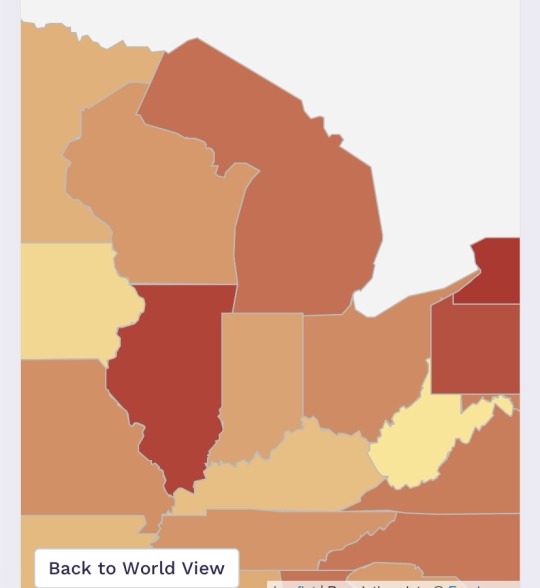
the fuck did they do to my state?😭😭😭
#was just trying to find out how popular my last name is#and i find my poor state mutilated🥺#also my last name is way more common than I thought#despite the only person I’ve ever met with the same last name#that isn’t related to me#is this immigrant janitor in florida#i knew it was more common in Latin America but apparently it’s not super uncommon in the US#a lot more in the southwest and Texas#but my family is texican and spent some time in cali so maybe there’s some distant relatives over there
0 notes
Text
This is a post complaining about the lack of feasible travel options in the US beyond car or plane.
I live near Austin, Texas. I have family near Albuquerque, New Mexico. This is about 700 miles.
This is a shitty drive in a car. About 11.5 hours (not including stops), and that slog through west Texas is rough. It's a lot of wear and tear on the car, and even in the hybrid, a lot of gas.
When we need to get there quickly, we have generally flown. Southwest has some direct flights, about 1 hour and 45 minutes, for about $175. (Plus renting a car when we get there.) But airport security sucks and is a bit of an environmental disaster. You spend more time in the airport than in the air. It's annoying, but is a decent tradeoff for time when that's important.
Riding a Greyhound bus is CHEAPER than flying (about $120 a ticket) but you are either going to Dallas, waiting for a new bus, to Amarillo, waiting for a new bus, to Abq (21 hours), or To Dallas, to Oaklahoma City, to Abq (25 hours.)
But Rosie, you might ask, why not take *the train*?
More environmentally friendly, and it can't take LONGER than driving, right? Or maybe a liiiitle if we are going to Dallas first? So it cant be longer than the BUS right? And it's a train, how fun!
This is a map of Amtraks tracks.

Suggested route 1: 30 hours
You can take a train to Ft. Worth, change to a different train to Oklahoma city, then take a bus to Kansas, THEN a train to Abq. $250 a ticket.
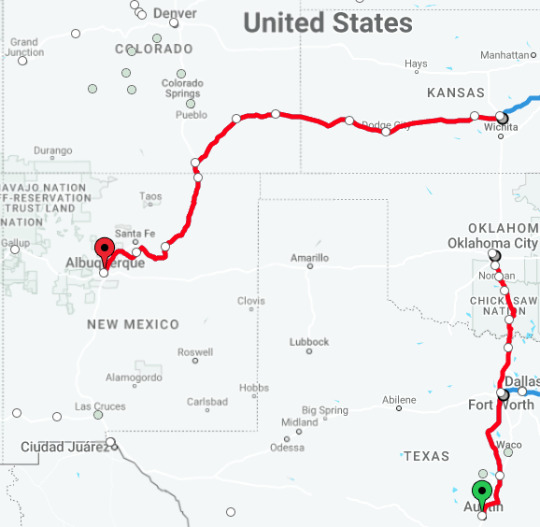
Suggested route 2: 54 hours
Take a train to ST LOUIS, then a BUS to Kansas City, then a different train to Abq. $300 per ticket.

And you still have to rent a car when you get there.

Listen, I know this isn't like... Amtraks fault. Amtrak has been intentionally sabotaged again and again, but holy Jesus. I *want* to ride the train. I would gladly *double* my travel time if the cost was reasonable and the route didn't involve having to switch to a bus halfway through?! But how can I justify 2 hours/$175 vs 54 hours/$300 AND A BUS TRANSFER?!
Again, not Amtraks fault directly.
youtube
#amtrak#rail travel#i live in the 10th largest city in america#theres a million people here#surrounded by deserts and wind mills and oil rigs and republicans on all sides#Youtube
775 notes
·
View notes
Text
Trans and Queer Resources for People Living in/near Albuquerque New Mexico, or Looking to Relocate in The American Southwest
I am making this post because this is where I live, and fortunately, there are a lot of queer resources available in the area. I was able to transition because of the resources here, and continue to feel safe and thrive here as a queer person, so I want to pass them on to anyone else who may need them:
General queer community resources:
Transgender Resource Center of New Mexico - Available to all ages- has a wide variety of resources for all trans, gender non conforming and nonbinary people including directing you to providers who will prescribe HRT, access to name changing and gender marker changes, support groups for a wide variety of identities, free food, housing programs for housing challenged and homeless trans people, and much more. Their building is also beautiful on the inside, they have a library of queer literature- I can't recommend them enough, I have been here personally.
LGBTQ Resource Center UNM - An LGBT/queer resource center located on the Las Lomas UNM campus. They provide a wide variety of resources including classes on safe sex, providing resources and support groups for various queer people, giving students access to safe and supportive housing on campus, counseling, HIV testing, food, and much more. They are available to be accessed by students and the general public alike
Albuquerque U21 (Commonbond) - A program and safe space available to any queer person under the age of 21 to socialize with other queer individuals and have a place to discuss queer issues. They also have community events such as DnD nights, cooking classes, book clubs and community speakers who discuss queer issues.
Casa Q - a program and shelter available to queer youth aged 14 - 17 who are at risk of homelessness or are struggling with housing stability, or other issues related to queerness and survival and staying housed.
PFLAG Albuquerque - a group which currently meets on Zoom that discusses queer issues in the community on the whole as well as locally in Albuquerque. A support group as well as a platform for activism and a place to go to talk to and find other queer people and resources.
Therapy, mental health services & other gender affirming care:
Bright Spaces NM - a way for queer patients to search for queer friendly healthcare providers in their area, as well as look for other programs provided by the organization.
Therapists specializing in helping transgender patients in the Albuquerque area - take lists like this with a train of salt, therapists love to market themselves as trans/lgbt friendly, but it's good to have a list to work with
Sage Neuroscience - a mental health care provider specializing a wide variety of conditions and hosting a wide variety of services including queer informed therapy, gender affirming care, medication management, group therapy, substance use help, and more.
High Desert Healing - a mental health care provider with a large number of queer specialized & focused therapists.
Southwest Care - have several providers which specialize in gender affirming care.
UNM Truman Center - a general health provider through the local university hospital system that providers gender affirming care services to a wide variety of local trans people. This clinic is severely overbooked and is used by a ton of local trans people, so try other places first before trying here.
Agora Crisis Center - a crisis center that is informed and safe for queer individuals struggling with mental health who need a safe place to talk about whatever issues they may be facing. They are a a hotline that can be called, and have a large list of local resources on their website as well.
For those of us who already live here, or given all that's happening right now, Texas and many other states are not a safe place for queer people of any stripe, and there are many folks looking to relocate to safer places in the American southwest for queer people and those who are looking to safely medically transition. Please keep in mind that most places in the US are in a housing crisis right now, so always do your research and sort out housing and safe relocation before making any decisions.
This is not a "move to here right now" post but rather a collection of queer resources available to people living here, as well as for people who are looking to relocate to a more queer friendly state in the American southwest. Albuquerque has issues like crime, it is not perfect here, so please be aware that it's not a good idea to just drop what you are doing and relocate to any place for any reason without doing research first. There is no place in the United States that is a "haven", we just happen to have a lot of queer resources here if they are needed.
I will add more resources as I find/think of them.
#trans#lgbt#queer#transgender#nonbinary#enby#lgbtq#lgtbqia#transsexual#mtf#ftm#trans man#trans guy#trans boy#trans woman#trans girl#trans lady#transfemme#transfem#transfeminine#transmasculine#transmasc#transneutral#transneu#trans resources#transgender resources#our writing#resources#save#important
508 notes
·
View notes
Text

In far west Texas and eastern New Mexico, there is a land so flat you’ll swear, if you squint hard enough into the infinite horizons, that you can see the back of your head. This treeless, sand dune, canyon and grass filled country stretches some fifty thousand square miles of land that used to be called The Great American Desert but today, is called The Llano Estacado or the High Staked Plains. In the deep past, it was home to Ground Sloths, Mammoths, and Bison before Clovis, Apache, and then the Comanche. The Spanish explored it, the New Mexicans hunted buffalo on it, the Americans fought the Indians on and around it. Coronado, Oñate, Kit Carson, and Robert E Lee all travelled across or around it’s flat emptiness.
In this Roadrunner exclusive episode of the American Southwest Podcast, I cover all of that and a whole lot more as I uncover the Tierra Incognita that is El Llano Estacado. I discuss what it looks like, how it distorts the mind, the creatures that live on it, the violent weather, the history of the American Indians including the mysterious Teya, the Spanish, The French, The English, the New Mexicans, the Comancheros, the Contrabandistas, the Ciboleros, the Texans, and finally, the Americans. I introduce important Southwestern Characters, animals, peoples, cultures, and battles. I quote from great authors who wrote fantastic books about the place that only those who hunted the bison, and those that hunted the bison hunters ever dared to venture into.
This is the first of many exclusive episodes for the Subscribers or Roadrunners and at 3 hours and 30 minutes, I hope that it satisfies everyone’s desire for awesome and exciting information on the American Southwest. Thank y’all for subscribing and listening.
Sign up at Substack!
#el llano Estacado#my podcast#Thomas Wayne Riley#the American Southwest#Texas#New Mexico#history#Comanche#Apache#Spanish#American#French#Coronado#Oñate#Robert e Lee#Mexico
47 notes
·
View notes
Text
I saw this post about crazy museum stories, and I see lots of retail stories, but I don’t see a lot of airport stories….
So here are some of my craziest stories from working at an airport.
Airport behind the scenes:
• The random passenger who told me to get off the carousel (I was fixing it) then absolutely couldn’t believe I was a female and a mechanic. Then he proceeded to insinuate my military rank before getting out meant I messed up (AF just ranks slower, we had a bit of a bottleneck problem when I was in). He then suggested my supervisor didn’t know how to do his job well and could “just take us all under his wing”. All of this before asking for a job…..
• The passenger who insisted I check him in for his flight that left 2 hrs ago, when I was fixing the ticket counter conveyor belt, all the lights were off and I was literally black up to my elbows in grease….
• The woman who rode up and down the glass elevator in ticketing, lifting her skirt repeatedly, until the sheriffs had to come get her. Bonus points: it was only around noon, and no she wasn’t flying anywhere.
• The woman who got demanded she get on a plane at 11 pm, when flights are no longer going out, with no ID or money, to a city that was literally a 45 min drive away, with no airport. She proceeded to stop pick up traffic with an airport use wheelchair.
• A man who went through an armed door to the ramp, took all of his clothes of and sat there (that one made news).
• A woman who decided to take off all of her clothes and run around the main part of the airport. A sheriff and 2 cleaners had to catch her, she ran through the parking structure at 1am, in January in the northern Midwest.
• The absolutely insane contract manager that almost got sued by Southwest Airlines for wearing disguises and hiding to catch their ticket counter agents putting begs on the belt wrong (they weren’t, also wearing 2 hats and a fake mustache is not inconspicuous sir) that was the talk of the airport for quite a while…
• The gate agent that somehow messed up the jetbridge so bad I had to take every single limit sensor apart so I could override it. When he called it in all I was told was “the wheel locked up and I kept moving it, and I made an ooopsies.”
• The coworker that would insist on wanting to empty the lavs (which is easier than loading bags) but would mess it up at least once every other week and spill on himself, then just look horrified but not move….
• A woman rode an unattended baggage belt, luckily she was read as an oversize bag and sent directly to TSA, she literally could have been killed. She scared the daylights out of some TSA agents though. Could you imagine- you expect a golf club bag or something and get a person popping out?
• The lady who was really scared to fly, got really drunk, and fell down an up escalator. It was Christmas and luckily the gate agents were able to book her on a new flight the next day for free. But when asked if she had someone to pick her up, she called her husband, in Texas… (this is an airport near Chicago) she literally didn’t even know what airport she was at. A sheriff took her to a hotel to let her sleep it off, and to my knowledge she made it out safe the next morning.
I found a cat stuck in a wall, well actually she climbed through the wall and became trapped in a plumbing closet. She is really lucky some Southwest agents heard her crying and called us (they figured since we worked on conveyors and had tons of tools, we might be able to help. We called airport ops to open the closet door, and there she was. I still have her to this day, her name is Delta, and she is a very weird cat, I blame it on the fumes 🤣
All of this and more, and I work at a relatively small airport, and I was only there 5 years, and primarily worked 3rd shift as a mechanic.
@karmaisntab
17 notes
·
View notes
Note
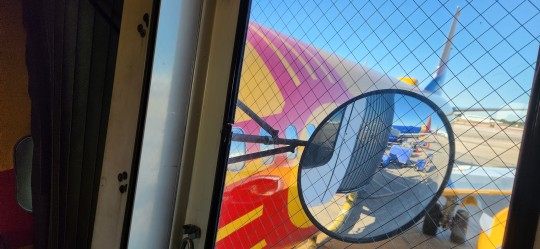
I was recently surprised to see this livery while boarding, and snapped a pic. Apparently enough people asked the crew questions to the effect of "Why is the plane yellow?" as we were boarding that the captain explained it during his take off announcements. Turns out we were on 'New Mexico One' (N8655D).
Maybe they were worried they accidentally got on a Spirit flight. Happens to the best of us. (Also, knowing pilots I think there's a legitimate chance he was excited about it himself and would have brought it up no matter what.)

This is your girl! This is actually New Mexico 1.2.0 - the New Mexico One livery is the fifth Southwest state livery, and one of the first special liveries they had full stop.
Southwest Airlines has had a lot of special liveries. The documentation is incomplete, but they have a timeline for them up to 2013 publicly available. It turns out there were at least three Shamu jets (unfortunately I cannot find the purported pictures of Herb Kelleher in a penguin suit), and that my guess was right - their first state-themed livery was a Texas one to commemorate their origin as an intrastate carrier.
Since then, they've released quite a few more in honor of some of their more-served or milestone states. The states with special liveries are Arizona; California; Colorado; Florida; Hawai'i; Illinois; Louisiana; Maryland; Missouri; Nevada; New Mexico; Tennessee; and of course Texas. These really vary in level of detail and inspiration, and I definitely have no desire or plans to do a massive joint post on them all. That is thirteen liveries. But there's one or two that have been hanging out on the distant fringes of my interest and one (Colorado One) has already been requested, so if anyone particularly wants to see any of them covered just know I am treating them as full, separate, self-contained liveries even though they're technically sort of a set. It just doesn't make any sense to do it any other way.
(I never want to see a Massachusetts One. The concept is actively repellant to me.)
Most of Southwest's special liveries have 'one' at the end, like Air Force One, you know, it's the famous plane, Air Force One, they made a film about it with Harrison Ford in. I do think hypothetically the implication of 'New Mexico One' would be a plane transporting the governor of New Mexico, but, well, that's their name scheme.
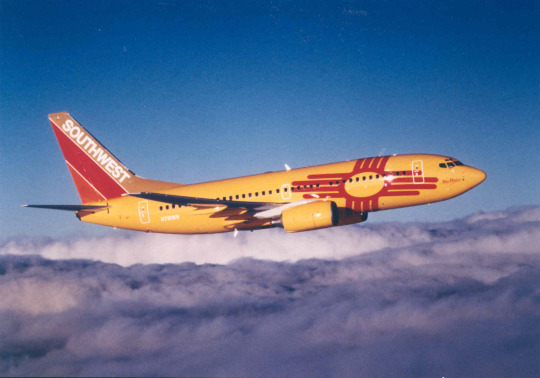
image: Southwest Airlines
This is the original New Mexico One, N781WN. Thanks to the information Southwest provides on its website for once I know the exact date a livery was debuted - 18th September, 2000. I'm not sure how to feel about the fact that this picture is younger than me, because it looks incredibly crunchy and vintage, like it couldn't have been taken later than 1985. I have a Polaroid SX-70 that was kept in working condition by a relative and it takes cleaner-looking pictures. It must have been taken very early on in the livery's lifetime because when Canyon Blue was introduced the tailfin was updated to match. As with all Southwest's special liveries - the tailfins remain untouched from the default.
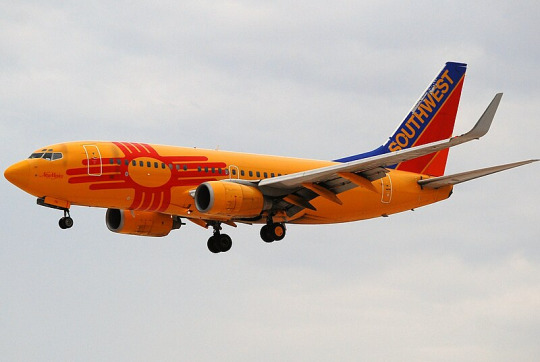
image: Eddie Maloney
The initial iteration with the mustard-yellow and red tail looks very nice, seamless with the main body. Although the placement of the name on the fin is quite subdued and against the ethos of the low-cost carrier it is in the case of special liveries useful, making the interaction of the wordmark with the main design a non-issue. Part of me really wishes that they'd kept the old colors for longer or maybe even done custom schemes for the stripes on each of their special liveries, because the blue looks pretty out-of-place on the New Mexico livery. I'll be completely honest, I also think the older, more angular shape of the stripes suits the similarly geometric bulk of the design while the modern incarnation - the haphazardly placed little wordmark with no natural home on the tail, the fin which looks like it was removed from a wholly different plane - is just sort of generally worse than the original state. The use of a minimally-altered tailfin with a crammed-on wordmark does seem to be something about which Southwest is unwilling to negotiate, though, and I guess that's what I'm going to have to live with.
(...generally, I do have to live with all the liveries I discuss here, until the magical day that someone at a massive company decides that the opinions of a blog with under 1,000 followers are something they want to capitulate to.)
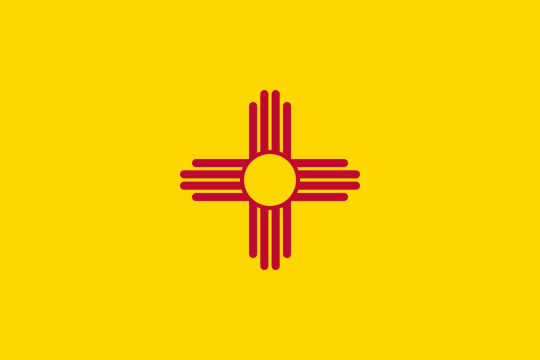
The basis of the livery is extremely straightforward. It's...the flag of New Mexico. This is a fantastic starting point. The New Mexico flag is my favorite of the US states' - though, to be fair, that's damning by faint praise in the extreme. Just based on the sorts of people I've met I feel like at least a few followers of this blog will have particularly vivid opinions about vexillology, but it doesn't take someone with the level of investment I have in liveries to know that most US state flags are just absurdly poorly designed. New Mexico's flag is not just acceptable but good.
Yellow and red aren't uncommon colors in flags, but the complete absence of very popular choices like blue and white definitely is striking. Unlike many US state flags, which are morasses of complex and jumbled iconography, it contains only one image - the sun symbol of the indigenous Zia (Tsi’ya) Pueblo group. Unfortunately, not only was the design not suggested by Zia individuals but it was used without the group's knowledge or consent, and there has been an ongoing discussion about this being properly acknowledged by the state - a good summary, albeit from 2012, is this El Palacio article written by the Zia Pueblo administrator.
I was pleasantly surprised to learn that Southwest actually did consult the Zia, including administrator and author of the above article Peter Pino. A contemporary news release from Southwest even discusses Zia children performing a Crow Dance as part of the ceremony. I was able to find a photograph of this in a blog post by a Southwest employee.
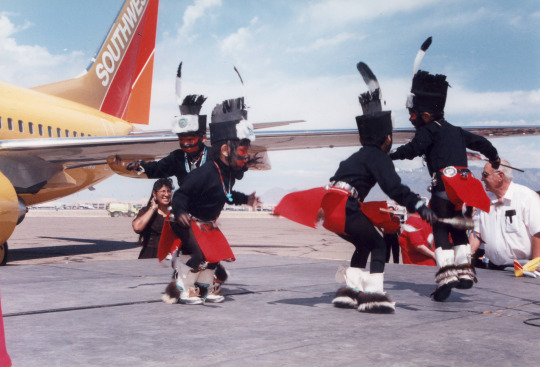
So safe to say people were pretty excited about this livery! Southwest's state liveries tend to be pretty beloved by the people from said state, as far as I can tell.
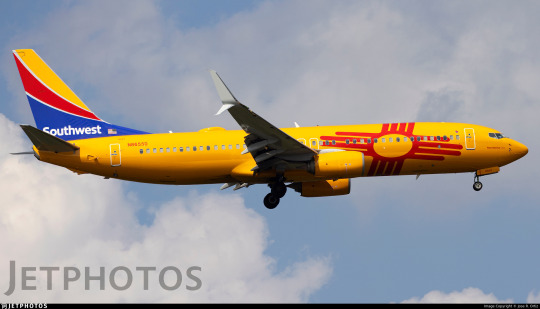
N781WN was retired earlier this year and sometime in the late summer the livery was repainted onto N8655D. The livery is largely unchanged except for the fact that it's on a longer plane now.
Anyway, I like New Mexico One. Not terribly much happens here in the way of detail so there's not much to say about it but I like the way it's placed at a sort of angle instead of just smacked in the middle of the plane directly above the wings or something. The fact that there's some yellow and red in the tail prevents it from looking as bad as it could (and definitely does on other state liveries) even though I kind of really genuinely dislike the wordmark placement like a lot. I'm not sure how they could have done it better. I just think if you're making it that small and out-of-the-way you could honestly just go without. Not like there's even one other plane flying around with this livery.
Why is the inside of the winglets totally bare? I can't be the only one that thinks that's strange, can I?
I'll give her a C+. I think there's a pretty low ceiling on how good a livery that's just the flag of New Mexico can be, and Southwest did a job I would call 'correct' - they didn't really mess anything up and they didn't have some sort of brain explosion that let them create a design more captivating than putting a good flag onto an airplane but leaving the tail Southwest colors. This is a good special livery and it seems like a nice little tribute to New Mexico, and it's always nice to see a beloved old livery be preserved on a new airframe. Congratulations to the people of New Mexico, particularly the Zia, on a pretty neat commemorative livery.
30 notes
·
View notes
Text
By: Ryan Burge
Published: Mar 25, 2024
I give a lot of talks about the "nones." This includes Zoom meetings, webinars, lecture series, and sermons at various venues such as churches, colleges, and social organizations. My slide deck is as dialed in as it can be. I know which statements will resonate, how to elicit a quick laugh, when to speed through a graph, and when to pause to let people take photos of a slide.
I aim to provide the audience with a few key takeaways from the talk. One of them is this: most "nones" are not atheists. I believe that when most people hear the term "none," they immediately picture an atheist. However, I emphasize the "nothing in particular" group more because it's significantly larger.
I do, however, believe that atheists are crucial for the future of American society and politics. As I've previously written, they are among the most politically active groups in the United States.
Link: No One Participates in Politics More than Atheists (paid article)
But how many are there? The Cooperative Election Study can help us with an estimate.
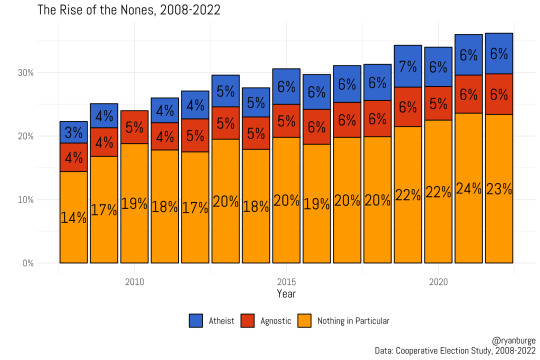
According to this data, about three percent of the adult population were atheists in 2008. This number has slowly risen over the last fifteen years. It was five percent in 2014, then increased to 6% by 2016. What's striking is that there hasn't been any appreciable increase between 2015 and 2022; it's remained around six percent.
I've also attempted to generate state-level estimates of atheists, which is not straightforward. When a group comprises only 6% of the general population, the margin of error increases. This is even more challenging at the state level, requiring a large sample size to include enough respondents from states like Vermont or Wyoming to produce confident calculations. Yet, I'm giving it a try.
Below, you'll find estimates of the atheist population for all 50 states. I used two sources: the Cooperative Election Study (CES) data from 2016-2022 and an estimate from Nationscape with has over 477,000 respondents. Despite the large sample sizes, four states in the Nationscape sample had fewer than 1000 respondents—Wyoming, Vermont, Alaska, and North Dakota. However, this is as accurate as it gets with the available data.

I visualized the estimates with 84% confidence intervals. A rule of thumb is that if the error bars from each survey overlap, the estimates are statistically similar. This occurs in some states like Georgia, Idaho, Maryland, and Mississippi. Generally, the CES tends to have higher atheist estimates than the Nationscape survey, but the differences aren't substantial, averaging a discrepancy of 1.9 points.
I'll now share the atheist estimates from both surveys for all fifty states to illustrate the range of these numbers.

In several states, one estimate may be 4% and another 5%, such as in Indiana, Ohio, West Virginia, Texas, and Florida. It's reasonable to conclude that in these locations, atheists may constitute one in twenty adults. Other states fall into a similar range, like Pennsylvania, Missouri, Nebraska, and Kansas. The largest discrepancies were found in Washington (4 points) and Oregon (5 points), it’s hard to figure out why this is happening in these two states.
To generate my best guess, I averaged the estimates from the CES and Nationscape surveys. Although the CES estimate might be slightly high and the Nationscape slightly low, the midpoint should provide a close approximation of the actual percentage.
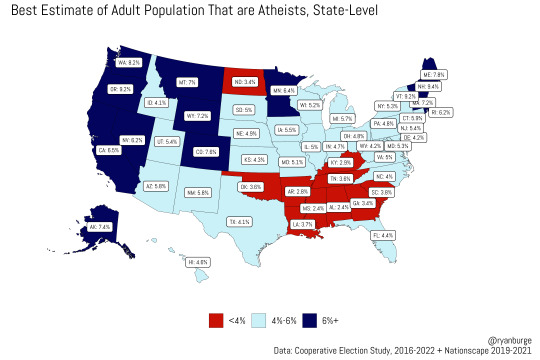
It's reassuring when the data align with perceptions - that’s the case here. For example, the Bible Belt displays a lower atheist percentage, with states like Mississippi, Alabama, and Kentucky showing shares below 3%. North Dakota's outlier status likely reflects the impact of sample size.
The atheist population in most states falls within the 4-6% range, encompassing the upper Midwest, the Rust Belt, and parts of the Southwest. Missouri, with a 5.1% atheist population, serves as the median state, aligning more with its northern neighbors than those to the south.
The dark blue states, which are most likely to have atheists, can be best described as including the Pacific Northwest, some Great Plains states, and New England. However, the epicenter is undoubtedly in the top left part of the map, with Oregon at 9.2% atheists and Washington at 8.2%. The only other states that come close are the relatively small ones: New Hampshire (9.4%) and Vermont (9.2%).
Let’s have some fun now, though. What factors predict a greater percentage of atheists? I think even amateur social scientists can probably do a bit of theorizing at this stage. Let’s start with some low hanging fruit - age. This is a scatterplot of median age on the x-axis and the share of atheists on the y-axis.
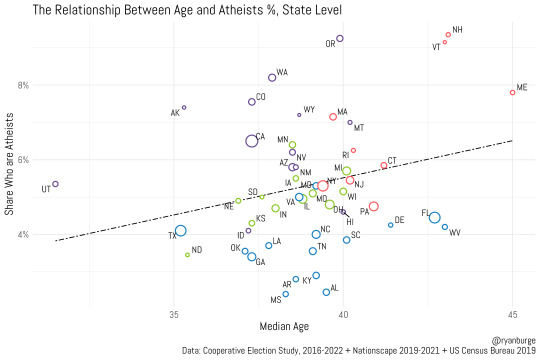
The trend line is unmistakably positive—states with older populations tend to have more atheists. Surprising, isn't it? Take note of the three outliers in the top right—New Hampshire, Vermont, and Maine. These states are both significantly older and have higher proportions of atheists than the norm. On the other end of the spectrum lies Utah, a notable outlier. Despite its relatively young median age of 31.5, its estimated atheist share is 5.4%, which significantly exceeds the expected trend of 4%.
But what does this correlation translate to in concrete terms? If a state were to age by five years, on average, it could anticipate a one percentage point increase in its atheist population. This change might not seem substantial, but considering the implications of a statewide median age shift of five years, the impact is noteworthy.
Let’s explore another influential factor: politics. I analyzed Trump’s vote share from the 2020 presidential election and plotted it against the share of atheists.
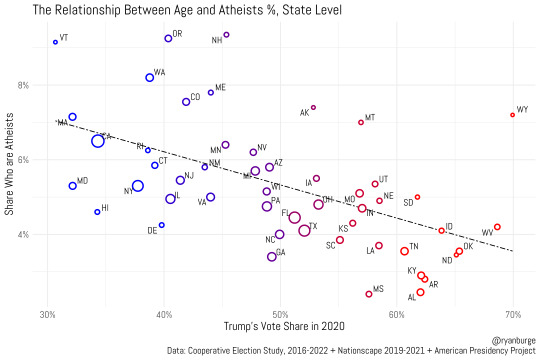
This relationship should be relatively straightforward to understand—the higher the percentage of Trump voters in a state, the lower the percentage of atheists. Vermont stands out as an anomaly in the top left, where only 31% of voters supported Trump and 9.2% of the population identifies as atheist. Massachusetts presents an interesting case for comparison; its Trump vote share was nearly identical, yet its atheist share was two percentage points lower.
Montana, Alaska, and Wyoming significantly deviate from the trend. I attribute this to two main factors: the small sample size and the unique political landscape in these states, where conservatism is not primarily driven by religious motives. A Republican in Montana is markedly different from one in Mississippi.
But what does this correlation look like in real numbers? For every ten-point increase in Trump’s vote share, the percentage of atheists decreases by about 0.9%. This is less than a single percentage point. For example, if Vermont's Trump vote share increased from 31% to 51%, we might expect its atheist share to decrease from 9.2% to 7.4%.
Before concluding this post, I put together a regression model with additional variables such as the percentage of the state population with a college degree, the median income, and the gender ratio to identify factors that influence the percentage of atheists. Here are the findings.
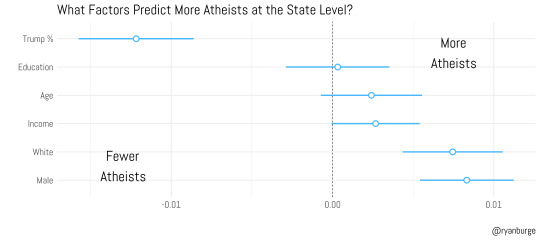
Education, age, and income did not provide statistical significance in this analysis, which is certainly noteworthy. The primary factor influencing the atheist percentage was political orientation. A higher number of Trump voters correlates with fewer atheists, all else being equal. Additionally, two demographic variables—higher percentages of white people and men—were associated with increased atheism rates. The effects of these variables were positive and of similar magnitudes, indicating that neither is significantly more predictive than the other.
It's important to emphasize that atheists have not been growing at an exponential rate in America. They accounted for six percent of the population when Donald Trump was elected President, and this figure remained unchanged as of 2022. The increase in "nones" is attributed more to a rise in individuals identifying with "nothing in particular" rather than a surge in atheism. While states like Oregon and Vermont have notable atheist populations, atheism is relatively rare in places like Alabama.
Link: Atheists Just Don't Have Many Kids (paid article)
The inverse relationship between age and atheism deserves further reflection. When combined with data from a previous analysis highlighting the low fertility rate among atheists, it becomes clear that the growth of atheism likely depends more on converting individuals from other traditions than on passing atheistic beliefs down through generations.
However, the relatively high incomes and education levels of atheists, coupled with their lower fertility rates, position them to continue exerting significant influence across various aspects of American life, both now and in the future.
==
Keep in mind that I understand Ryan's definition of "atheism" to be, "believes that no god exists."
A better definition is anyone who isn't a theist. If you don't positively affirm belief in a god or gods, you're an atheist.
#Ryan Burge#rise of the nones#leaving religion#no religion#irreligion#atheism#decline of religion#empty the pews#religion#religion is a mental illness
11 notes
·
View notes
Text
Spoilers for the new episode
AND a really nerdy rant about a subject I'm passionate about (land surveying.)
...I know. I know. Hear me out here...
So while y'all are over here freaking about Gov's secret family I'm here cracking up at Tennessee describing his boundaries.
So my literal job irl involves land surveying and the description of Tenn's borders is not even an exaggeration for how completely fucked old land descriptions can be.
It's a historic European-influenced survey system called "metes and bounds" which relies on physical landmarks and--sometimes--local lore to describe boundaries.
[On TN's border with Mississippi]: "Okay, so you're going to go exactly 26 chains and ten lengths north of the Thompson's line, and..."
[On the border with Georgia]: Tenn: "So there's this rock, right? ...it's two feet high, four inches thick, and fifteen inches broad. You got to start there, then you got to find the sort of middle of the near town... and go near the top of the mountain nearby. And then you got to find where Georgia and Alabama allegedly meet. Oh wait a sec? Do you even know where John and David live? You're going to need to know that!"
That's the shit I deal with all the time in my job. 😂 it's not even an exaggeration: that's literally how they're written.
They replaced the metes and bounds system with the public land survey system, which divides the rest of the country into a rectangular grid. It's *slightly* less fucked but as you can imagine, drawing a 2D grid on terrain that's NOT at all flat is going to result in interesting and weird errors!
Map of the public land survey states and non-PLS states because I'm completely feral for this shit:
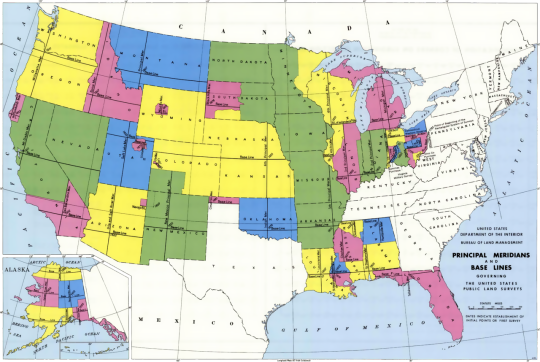
Colored states are PLS (rectangular grid) and white states have a different system. Most of the OG13 colonies (and Tennessee obvs) use the old metes and bounds system and most of the west (with one notable exception *coughTexascough*) use the rectangular grid.
Texas was surveyed by Spain and then Mexico first so they have their own system (because of course they do). So was the rest of the Southwest so there's massive Spanish land grants that the US grid just kinda... incorporated 😂
BUT long story short. If you look at an aerial view of like, North Dakota, you get THIS:

It's squares!!!!
This was how it was *supposed* to work.
But in places like Nevada that have mountains it's more like
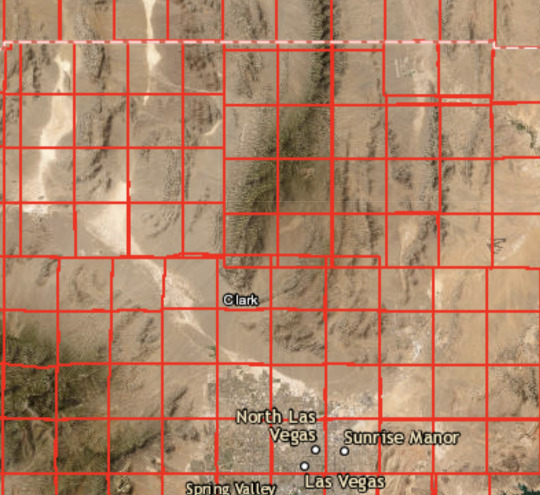
There are lots of places where they were just like "fuck walking through this desert; let's guesstimate."
24 notes
·
View notes
Text
Was researching stuff and encountered a wild suggestion from the major English-language search engine:

“Do hummingbirds live in the Andes?”
Hummingbirds are only found in the Western Hemisphere. Put another way: Hummingbirds only live in “the Americas.”
Depending on who you ask, there are between 325-ish and 360-ish unique species of hummingbird (in formal taxonomy, this includes the birds in the hummingbird family, Trochilidae).
Of those hundreds of hummingbirds, only about a dozen or so live north of Mexico, mostly in Texas and the Southwest. But those other hundreds of hummingbirds? Farther south. And so hummingbirds are closely associated specifically with Latin America.
The highest local (”hotspot”) biodiversity of mammals, birds, amphibians, and plants on the planet all occurs in the tropical Andes (specifically, within Ecuador and Colombia). The tropical Andes mountains feature extreme elevation changes in small areas (they’re very steep), which means the temperature situation changes rapidly in a small area depending on elevation, and the steep topography also means that clouds are forced to rise and/or descend rapidly in a small area resulting in lots of rainfall. And with the diversity of temperatures and rainfall, there is so-called “altitudinal zonation,” meaning that many different habitat types (lowland forest, cloud forest, scrub/grassland, alpine areas, etc.) can occur very close to each other. More biodiversity. And any time high-elevation and steep mountains are found closer to the equator, the biodiversity is amplified.
Like this:

And the high-elevation ridges and mountain-tops of the tropical Andes occur in very narrow bands, mostly limited to within the political borders of the nation-states of Peru, Ecuador, and Colombia. The higher slopes of the tropical Andes are home to cloud forest, and cloud forest provides a home to many flowers/orchids, and therefore also home to many hummingbirds.
How many hummingbirds?
Here’s a map of predicted species richness taking into account only 276 of the hummingbird species. This comes from a 2021 study. The map is described: “Hummingbird species richness based on the aggregate [...] predictions of 1 km resolution distribution models [...] for 276 species.”

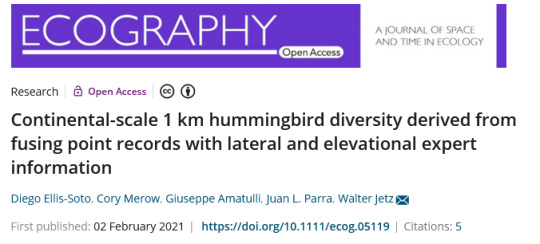
Source:
Diego Ellis-Soto, Cory Merow, Giuseppe Amatulli, Juan L. Parra, and Walter Jetz. “Continental-scale 1 km hummingbird diversity derived from fusing point records with lateral and elevational expert information.” Ecography. Volume 4 Issue 4. February 2021.
Compare the hummingbird species richness map to a map of the tropical Andes:

What did the 2021 study predict?
“The integrated models identified a region southwest of the city of Cali, Southwest Colombia as global 1 km2 hotspot of species richness for the 276 hummingbirds in the analysis (Fig. 5). This region borders Ecuador and covers a wide elevational gradient with 80 predicted hummingbird species.”
In the tropical Andes of Ecuador and Colombia, there are up to 80 different species of hummingbirds living within one single square kilometer of space.
In a small space the size of, like, a city park.
80 hummingbirds.
Think about the array of colors. Hummingbirds are celebrated for their vibrant and diverse plumage.
How many shades of violet, blue, hot pink, orange, in just one square kilometer, perhaps on just one hillside?
Consider this:
Across vast regions of North America, there are usually between one and maybe four species of hummingbirds present. But in the tropical Andes? Dozens of species on a single slope.
More species of birds live within Colombia than in any other nation. About 1,900 species of birds live in Columbia.
One-fifth, 20% of all bird species on the planet can be found in Colombia.
Of 360-ish species of hummingbirds on the planet, about 165-ish or more can be found within the borders of Colombia. And at least 15-ish species of hummingbird are endemic to Colombia, meaning that they only live within Colombia.
Among the endemic species of hummingbird in Colombia, the green-bearded helmetcrest only lives in Eastern Andean paramos habitats where it has a close association with the flowers of the unique high-elevation espeletia plant. The critically endangered dusky starfrontlet only lives between 2300 and 3500 meters of elevation near Colibri del Sol ProAves Reserve. And on the mountains of the Caribbean coast, there is the endemic Santa Marta blossomcrown, found up to 1700 meters in elevation. And above that? On the same slopes? The critically endangered blue-bearded helmetcrest only lives above 3000 meters of elevation in rugged habitat along the Caribbean coast in the Sierra Nevada de Santa Marta.
This is the power of the tropical Andes, the same mountains that were the original home of tomatoes and potatoes, where the headwaters of the Amazon are born.
131 notes
·
View notes
Text
more has come to light about the person sharing false info about beau and it’s a different clinic than we thought, but they’ve apparently shared about a lot more than beau. they’ve made up a lot of very unfriendly rumors, so just know that if you ever hear anything unsavory about our breed, people IN the breed are your best source of info! silken people in general are pretty forthwith ime and will talk about both the good and bad. talk to a variety of people, meet dogs yourself if possible, and just be careful where you get info. you’d want to make sure too that if you hear about a specific region, you talk to people FROM that region, or who have at least visited. being on the west coast, for example, i can’t really speak to what’s going on in colorado or texas or the east coast with certainty. nor could someone from, say, canada tell you what silkens are like in the southwest. talk to puppy buyers from breeders you are interested in, talk to other breeders who have worked with them. but definitely don’t just believe things you read online! and if a sentence begins with “i’ve heard” or “people were saying,” probably best not to give it any thought. :)
77 notes
·
View notes
Text


Eclipse projects shed new light on solar corona
Teams led by Southwest Research Institute successfully executed two experiments—by land and air—collecting unique solar data from the total eclipse that cast a shadow from Texas to Maine on April 8, 2024. The Citizen Continental-America Telescopic Eclipse (CATE) 2024 experiment engaged more than 200 community participants in a broad, approachable, and inclusive attempt to make a continuous 60-minute high-resolution movie of this exciting event.
A nearly simultaneous investigation used unique equipment installed in NASA's WB-57F research aircraft to chase the eclipse shadow, making observations only accessible from a bird's eye view.
"Total solar eclipses are relatively rare, offering unique opportunities for scientists to study the hot atmosphere above the sun's visible surface," said Dr. Amir Caspi, principal investigator of both projects. "But more than that, through CATE 2024, the eclipse offered a bonding experience between scientists and communities along the path, sharing in this incredible, awe-inspiring event. We hope the public experienced a new interest in and appreciation of the sun and its mysteries."
Total solar eclipses allow scientists to view the complex and dynamic features of the sun's outer atmosphere in ways that aren't possible or practical by any other means, opening new windows into our understanding of the solar corona. The faint light from the corona is usually overpowered by the intense brightness of the sun itself, and some wavelengths of light are blocked by Earth's atmosphere.
CATE 2024 deployed a network of 35 teams of community participants, or "citizen scientists," representing local communities along the eclipse path, deploying a "bucket brigade" of small telescopes following the eclipse's cross-country path. CATE 2024's scientific objectives required measuring the polarization of light, or the orientation of oscillating light waves, in the corona.
"You are familiar with this because sometimes you wear a polarizing filter right on your face—sunglasses that filter out certain angles of polarized light," Caspi said. "The Citizen CATE 2024 telescopes have a polarizing filter baked onto every pixel of the sensor, allowing us to measure four different angles of polarization everywhere in the corona, providing a lot more information than just measuring the brightness of the light."
Caspi also led an airborne project to observe the corona during the eclipse from 50,000 feet. These high-altitude observations both provide measurements that can't be made from the ground and avoid any weather-related risks. Caspi's team deployed a new suite of sensitive, high-speed, visible-light and infrared imagers, built by the SCIFLI team at NASA's Langley Research Center, installed in the nose cone of a WB-57 jet.
Looking at complex motion in the solar corona at new wavelengths and with new polarization measurements will help scientists understand why it is so hot. The corona is millions of degrees Celsius, hundreds of times hotter than the visible surface below, a curious paradox that is a longstanding scientific mystery.
The corona is also one of the major sources of eruptions that cause geomagnetic storms around Earth. These phenomena damage satellites, cause power grid blackouts, and disrupt communication and GPS signals, so it's important to understand them better as the world becomes increasingly dependent on such systems.
"Combining the airborne mobile data with the CATE 2024 hour-long string of observations will provide a more complete picture of the sun's mysterious corona," said SwRI co-investigator Dr. Dan Seaton, who serves as the science lead for both projects.
"Both experiments required an enormous effort and precise timing to get the data we need," Caspi said. "I am honored and in awe of the exceptionally talented teams that worked so diligently together. I can hardly wait to dig into the data we collected."
TOP IMAGE....This high-res processed image of the April 8 eclipse shows the Sun's corona, its outermost atmosphere, in artificial colors that indicate the polarization or orientation of the light. Citizen scientists in Dallas collected these data through the SwRI-led Citizen Continental-America Telescopic Eclipse (CATE) 2024 experiment. Credit: Southwest Research Institute/Citizen CATE 2024/Ritesh Patel/Dan Seaton
LOWER IMAGE....These preliminary images from a new suite of sensitive, high-speed, visible-light and infrared imagers aboard one of NASA's WB-57 jets show the corona and prominences visible during the April 8, 2024, eclipse in four wavelength ranges. Moving forward, SwRI scientists will significantly improve the images through processing and analysis of the rich and complex data. Credit: Southwest Research Institute/NASA/Dan Seaton
3 notes
·
View notes
Text

GALTx eNews: Summer Should Be About Sunshine!
Summer arrived like a blast furnace and everything from the temperatures to the cost of dog food is going up like crazy... everything that is except for our bank account balances. Foster homes continue to be one of our tightest resources. To keep doing what we do, we rely on our boarding facility, but it can be expensive. We need your help right now to stay ahead of the summer bills. Here are some of the expenses currently depleting our reserves:
With the rising temperatures, we are consuming more electricity to keep the hounds in boarding comfortable. Texas recently recorded the highest ever daily demand for electricity which is pushing up the rates, both in the short term and long term. We are anticipating a weather related surcharge on our upcoming bills and bracing for it.
Our water bill is also up considerably. We suspect we might have a leak, but have yet to find it. While we understand the water company might work with us on a high bill related to a leak, we cannot count on them to do so indefinitely. We need to find and fix the problem, which will likely require an expensive plumber.
The southwest exercise yard needs to have new sod installed and to have the temporary fencing added to keep the hounds safe.
We have added much needed shade covers to the dog runs and need to repair some of the plexiglass dog doors that have cracked. As with any property, everything needs to be maintained and repaired from time to time, especially with the heavy use of multiple dogs.
The clothes washer used to clean all the bath towels and rags is broken and so old that it likely cannot be repaired. We anticipate that it will cost about $750, with delivery and installation, to replace it.
The hounds' Kuranda dog bed covers get a lot of use and we needed to replace 25 of them at a cost of about $32 each. This expenses alone came out to a staggering $800.
We also need more supplies for the hounds such as the calming tabs, Benebones, and raw food toppers that can be purchased for us directly from our Amazon wish list.
Even the price of sending our weekly emails to keep everyone up to date and let you know of our needs is rising by 16% starting on July 1st. It seems unending and we hate to keep asking, but please consider giving a little or a lot to get us through the summer crunch. You can give on our website, on Facebook, or on Instagram. Thank you!
Click To Give
6/29/23
#greyhounds#snootblr#dogblr#dogs#greyhound#greyblr#sighthounds#galtx enews#pets#greyhound adoption#Summer Sunshine#Kennel#Boarding Facilities#Expenses
12 notes
·
View notes
Note
ooooh please tell me more about texas boy parker
i would be DELIGHTED anon; you have no idea how excited this ask made me ahahah. a lot of this is related to the apocalypse au specifically, but texan parker is a forever hc for me
firstly this fic i wrote (though its in the college band au) is, among other things, about texas boy parker so 👀 might be worth a read lol
he grew up in southwest texas, in a town called alpine! it's an "everyone knows everyone" type of place, and as he also has a twin sister (who he hasn't heard from since the apocalypse starts in this au ,,, ahaha,,,,,) he had a lot of trouble determining who he was/his plsce in the world apart from his family
thus, leaving feels just like a necessary step within self-discovery. its not so much that he hates where he came from, but he struggles for a long time about what alpine repesents overall in his life. he has a lot of fondness for the town itself, but doesn't ever really what to think on what that "fondness" actually is (ie just nostalgia vs genuinely still caring)
though he had a period of time as a teenager where he heavily rejected any cowboy/western motif, thougu it was always pretty natural to who he was and by the time he hit college he'd returned to embracing southern culture :]
when he was in school, his classmates would tease him for the way he talked, as most of them didn't have parents who'd grown up rural and consequently had no discernible accent. thus he trained it out of his voice the best he could (though it wasn't perfect)
^ later, after moving to arkham, he realized that he didn't want to be ashamed of his roots and stopped "fighting" it when it slipped out, which eventually devolved back into the drawl that faroe also ends up gaining in the apocalypse au. its also much stronger whenever his emotions are heightened (upset/excited/etc)
he plays guitar (and teaches faroe the basics :)) gravitating towards bluegrass chords before anything else as that was the colloquial music heard around his hometown, even if he lightheartedly denies the preference. (his guitar also has a sticker of the texas flag on it :))
oscar calls him cowboy, he acts like he hates it but tbh he really likes it lol despite pointing out that he isn't technically even a cowboy
being queer in a small, religious, southern town was a recipe for disaster, so he kept his head down and his mouth shut. he wasn't even worried about himself, but, for a multitude of reasons, how it would reflect on his parents. it made him cagey about his identity even after leaving tx, to the point he had a lot of trouble opening up to/growing closer with arthur because of it.
i think texas overall just represents SO MUCH for his character as a whole; he chases danger with the sort of spark that only starts in a dead-end small town, he doesn't look it but he can 100% hold his own in a fight, he's always moving not in pursuit of anything, but in fleeing of what he's scared of accepting
#jfc i project on this guy a LOT jsksjkdn.. twirls hair hes so me#i hope this is kind of what you were thinking anon LOL i feel like its a bit scattered#finch chirps#finch's headcanons#malevolent apocalypse au#parker yang#askbox
3 notes
·
View notes
Note
trick or treat :3
happy halloween pidge :D
parker yang is from the south!!
i've briefly talked about this in tags iirc but never really expanded on it, so; he grew up in southwest texas, in a town called alpine! his family still lives there—his dad runs a music venue in the heart of the town and his mom works in the administration department at the local university, where his sister is an undergrad studying chemistry.
in a mostly-canon sense, he left alpine because he couldn't really pursue the type of career he wanted there. the local police department was nothing more than a few farmers with pistols who didn't take very kindly to his few haphazard suggestions to form an investigative unit, so he chased the strange stories he'd heard about places up north until settling in arkham.
for aus (specifically the college band au) it's moreso his needing a change of scenery & the chance to figure out who he is away from his family and the ties to his hometown. i've got a parker-centric fic in the works about this, but after graduating he keeps making music & ultimately ends up with a lot of complicated feelings about alpine; growing up he was always ready to get away, but now that he can't go back, he ends up torn about his identity as a southerner, a queer man, and as a well-known musician.
send me a "trick or treat" headcanon ask!
#parker yang#malevolent#if you see this post and have no idea whats going on; i'm doing headcanon trick or treat today :D#headcanon halloween#< tag for organization :)
4 notes
·
View notes
Text
No. 40 - Southwest Airlines

One of my most requested posts, it's time to cover a carrier anyone who's flown in the US is probably very familiar with. After all, Southwest has for decades been the largest low-cost carrier in the world by both revenue and fleet size (though IndiGo is coming for that title).
Southwest's history is longer and more substantial than many may think, a central figure in the genesis of what we now know as the low-cost carrier. But one thing I think a lot of people know is their livery.
A common theme on this blog is trends in airline liveries - in particular, the modern trend towards the minimalist, sterile, underdesigned, and above all generic. As an anecdotal example, someone who lives near Boston's Logan Airport, the 16th-busiest airport in the US and 30th-busiest in the world, served by every major US airline and every major international carrier from countries within 787 range, were they to watch the takeoffs and landings, would be treated to the following...menagerie.
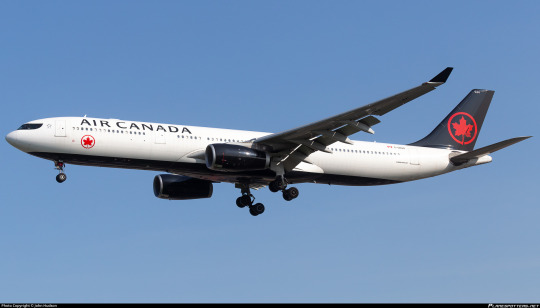


Can you believe these planes fly for different and indeed unrelated airlines?
Safe to say from 5,000 feet below it's a challenge to tell these planes apart. Even taxiing past them you'd need to pay attention. If I forced someone to squint I'm not sure they could identify them properly. How about Southwest?

Bam.
Southwest Airlines was founded in an era that borders on incomprehensible to those of my age bracket. The United States is a nation united in grumbling about Spirit Airlines, and most of Europe is constantly cursing Ryanair under their breath, but it wasn't always like that. The fact of a united enemy at all is new in the US. Back before the 1978 Deregulation Act, it was so prohibitively expensive to operate interstate flights that most airlines just didn't. Interstate flights were left to giant full-service airlines like Delta and Eastern, while international flights were the domain of an even more elite few - Pan Am, TWA, Braniff, and National (no, not that National, the other one) while the scrappier little companies flew short hops for commuters.

One airline which emerged in this pre-deregulation era was Pacific Southwest Airlines, commonly abbreviated to PSA, an initially tiny airline operating in California. You may recognize them from my icon! PSA is one of the single most important airlines in history because it all but invented the idea of the low-cost carrier. Beyond that, they were a Fun Airline. And while they were flying their grinningbirds all over California something else brewed in the background.
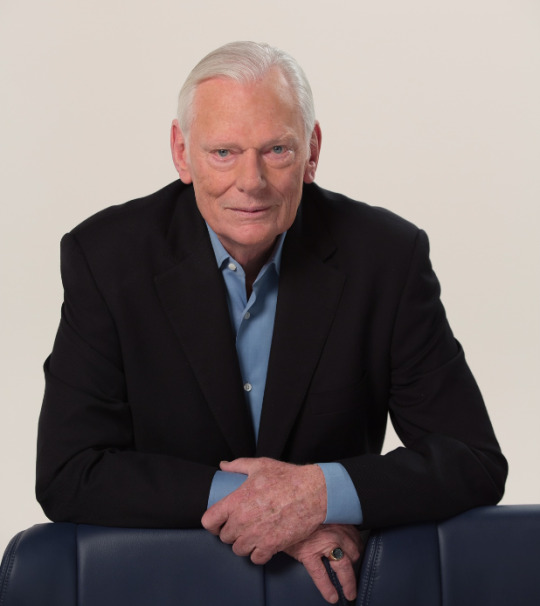
image: SouthwestArchive
I have never before in my life seen such a profound pairing of undereye bags with the slicked-back hair and piercing blue eyes of a YA dystopia novel film adaptation villain, darting around to lock onto any sources of potential wealth ripe for acquisition.
In 1971 Southwest Airlines began operating flights. The company was actually incorporated in 1967 (as Air Southwest), the brainchild of then-lawyer Herb Kelleher (and two other people who nobody ever talks about because they're boring). They saw what PSA was doing and saw potential for the massive profits that could be gained from avoiding fees from operating interstate and charging drastically lower fees than the larger carriers. Unfortunately for them the larger carriers also realized this, and they were trapped for three years in lawsuit purgatory, with Braniff, Continental, and Trans-Texas Airways taking the case all the way to the Supreme Court, who apparently declined to review it, recognizing that 'they have come up with an idea that will make them make more money and us make less money' is not a particularly powerful legal argument.
And with that little hurdle over Southwest was open for business! Though they weren't quite starting out as a single rented DC-3 Kelleher very closely modeled the airline after PSA, who seemed to be okay enough with it if them helping to train mechanics at the nascent airline was any indication. After all, at this point they were both intrastate airlines fundamentally unable to compete with each other - Southwest was staying put in Texas with no reason to think this would change anytime soon. They brought a bit of PSA to the state, like the low fares and the stewardesses in hot pants and go-go boots.


So what was their answer to the grinningbird?

The rare and deeply cursed Southwest 727.
The mustard rocket. It was called "desert gold" but I think we all know that this is mustard. At this point in history brightly colored airplanes weren't even unusual either, so it would have just been regular ugly instead of ostentatious. (I mean...I like this shade of mustard yellow, honest, but I recognize that most people think this is hideous.)
Southwest kept on Southwesting from there. These days, they're massive, and the most common response on my questionnaire for best airline experiences. No comment, as I've never flown with them. Highlights of their journey there include getting a federal amendment passed because they didn't want to relocate their hub from Love Field to Dallas-Fort Worth, getting sued for only hiring female flight attendants, having the first Black chief pilot of any major airline in the US, technically legal tax evasion measures, having to invent elaborate work-arounds for the restrictions placed on them which could have been avoided by just relocating to Fort Worth, absorbing a bunch of other airlines, being the launch customer for both the -300 and MAX 8 models of the Boeing 737, and making approximately a zillion dollars. In 1990 they absorbed Morris Air, a vacation charter airline which developed innovative cost-cutting measures like e-ticketing, including high-up positions on the Southwest corporate ladder for the founders...
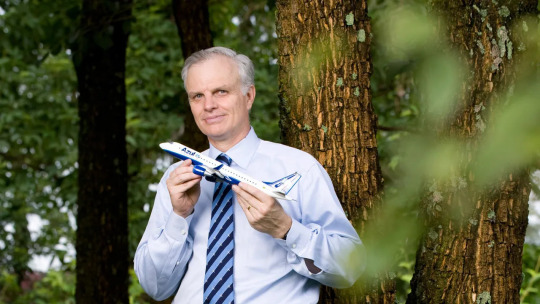
image: conde nast traveller
Strange millionaires lurking in woods distributing model airplanes is no basis for an airline industry! ...scratch that, it does appear to be working.
...oh, for heaven's sake, there he is again. Yes, David Neeleman's cost-cutting acumen was indeed put to use at Southwest, meaning that between this and founding jetBlue he basically created low-cost carriers. I reluctantly tip my hat to the man. I would not be able to afford airline tickets without him. But he's just everywhere.
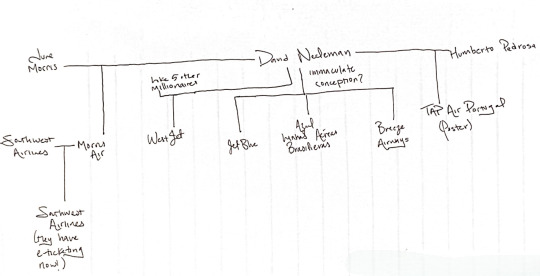
Here is my handwritten faMintly tree. Southwest is jetBlue's cousin once removed, do with that what you will. Anyway, let's hope I never have to add to this. (Not least because I already binned the piece of paper I wrote this out on.)
The turn of the century brought new things for Southwest! In 2000 they had their first major accident (a nonfatal runway overrun resulting in loss of the aircraft). Unrelatedly, in 2001 they released a new color scheme for their fleet, now several hundred strong and entirely composed of assorted models of Boeing 737.

The era of Canyon Blue had begun.
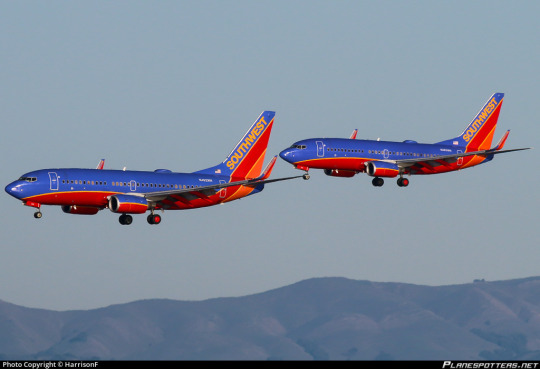
I mean, it's a statement. At this point a plane painted to look like a poisonous frog was in fact a pretty major statement. They were setting out to be an eyesore and I'm sure people were upset about this one, but to the modern eye it looks muted and unfinished. Still bluer than anything David Neeleman had made at that point, but not quite what we know today.
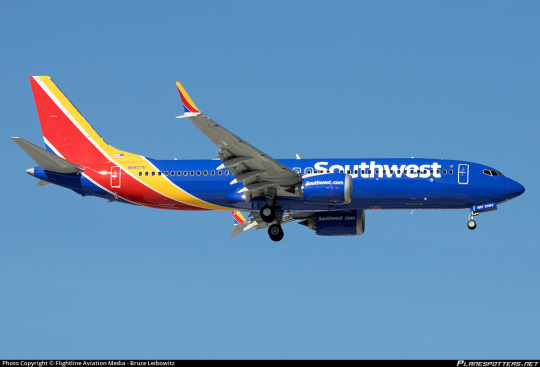
Okay. Yes. There we go.

This livery is meant to be the heart from their logo, the same one worn where the plane's heart might be if planes had hearts instead of air-conditioning systems, the colors unwrapped and deconstructed. And boy, is it almost violently colorful! It goes so far that it takes a minute to notice only three colors, plus white, are used in the entire livery. It's almost eyestraining, and I did have to turn the contrast down on my monitor while writing this because I'm fairly photosensitive. It's...less painful when pixels aren't involved.
So this is definitely one-of-a-kind. Well, it was. jetBlue has made choices recently. But this livery is definitely not one that gets lost in the crowd.
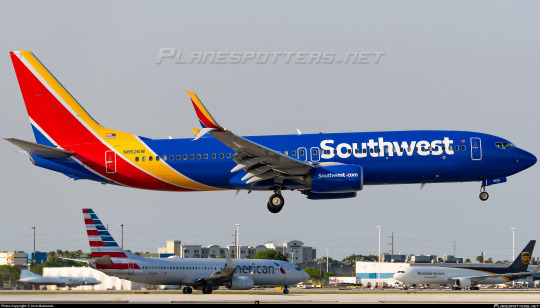
There's very little white or even silver on this airframe, in sharp contrast with...basically every airline. The rest of the livery is vivid and searing yellow and red, unusual shades in airlines, which tend to stick to slightly more muted schemes. And if you couldn't tell who they were by that, the big white billboard wordmark would let you know real quick. I think the white is a bit less legible than I'd like, but I'm not sure how to improve that without making it genuinely eyestrainy. At least it's large and visible, which is crucial for a low-cost carrier, instead of subtle and out of the way on the tail. That might work for an airline with a prestigious air, but that's not Southwest. Southwest is blue and yellow and red.
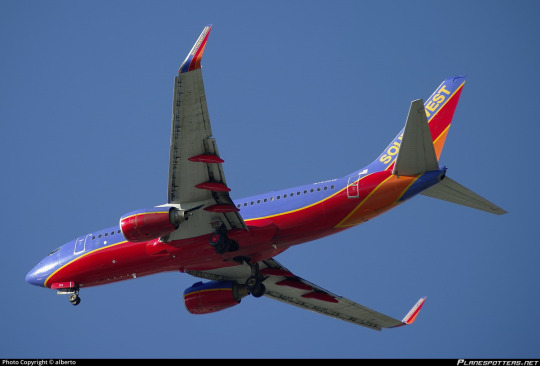

The main differences between the modern livery and Canyon Blue are in the placement of the logo and the colors used. Each shade is brightened significantly, which is why the once-garish Canyon Blue now looks pretty dusty in comparison. They entirely removed the blue from the tail, making it the airframe feel a little less like it's blue with accents and a little more like it's a circus tent. I do wish the yellow and red covered a bit more of the belly, but still...wow.

Some uses of Southwest Sans demonstrated.
The success of this design isn't by accident. Apparently, Southwest consulted no fewer than five design firms, and the font used for the livery and all their material (which I think looks totally fine) was actually commissioned from iconic foundry Monotype. A lot of airline liveries are designed in-house, and that can turn out fine, but Southwest clearly pulled out all the stops and it shows.

Southwest is a low-cost carrier, and this does affect the standards by which I judge their livery. They aren't here to be guided by legacy or decorum the way a flag carrier is - they're here to sell you a cheap ticket on an airline with funny cabin announcements. Circus tent with big lettering in a sea of Eurowhite? Nice, clean execution - I'd call that a job well done.
Grade: B

#tarmac fashion week#era: 2010s#era: 2020s#grade: b#region: north america#region: united states#low cost carriers#requests#southwest airlines#neelemanverse
41 notes
·
View notes
Text
Tips for writing across the US:
Unless otherwise noted, the line between 'West' and 'East' is the Mississippi River.
The Western US is dry. Most people know that, but it means that forests West of the Mississippi are a lot sparser, and they have less groundcover. If you want someone to be in a forest that swallows them up, you want it back East. Also, most of the rivers in the southwest are seasonal, they dry up part of the year. mostly due to groundwater pumping and intensive agriculture, but still.
A lot of chains that seem universal are actually tied to regions. There is exactly one White Castle out West, for example, while In-N-Out Burger only goes as far North as Oregon and is not present back East. If you want to mention a chain, take a moment to check it's present in that area.
Toll roads are far less common out West, and unlike some places back East are easy enough to avoid. Kansas and Oklahoma in particular make it almost impossible to drive across the state quickly without paying some sort of toll.
Highways back East have a minimum speed, and normally people drive no faster than five miles over the speed limit, though there are exceptions (terrible, aggressive drivers are everywhere, unfortunately). Out West there is no posted minimum speed limit, but that's ok, because Western drivers as a whole have decided to treat the speed limit as a minimum speed. I've found Texas drivers tend to ignore the speed limit entirely, rather than driving 10+ miles over the speed limit.
Small towns in the US often make money by ticketing visitors for traffic violations. It's a significant portion of their revenue, so cops are on the lookout. This is especially bad for People of Color. Exacerbating this is that driving laws vary from state to state. For example, Arizona is one of the few states that lets you make a U-turn unless it's expressly forbidden.
Buildings out West are a lot lower to the ground, they tend to be more spread out because we have more room. There are still skyscrapers, especially in the biggest cities, but you'll see a lot fewer of them.
States are not uniform! Rural areas in blue states are conservative, and cities in red states are liberal/progressive. There are also some towns that are outliers, either more liberal or more conservative then you'd expect.
If you have anything you'd like to add to this post, feel free to share!
6 notes
·
View notes